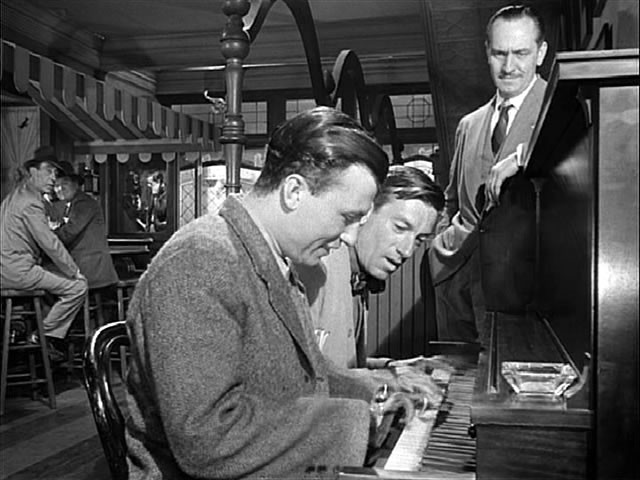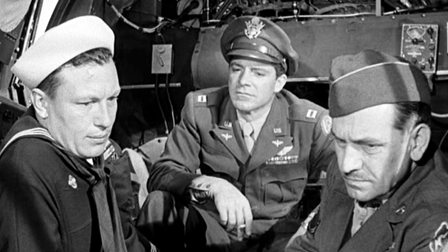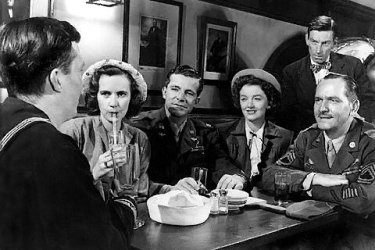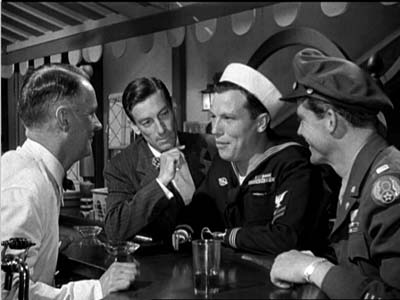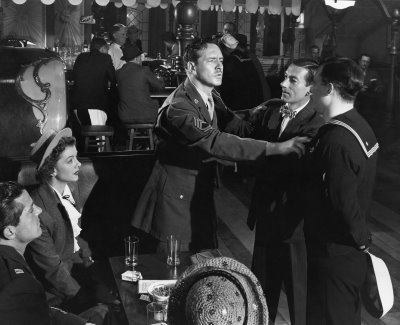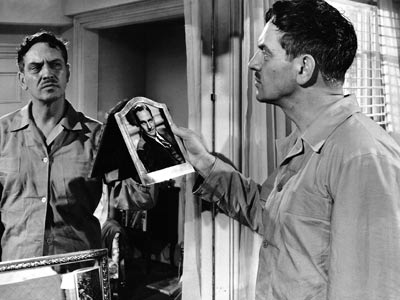In my more than 20 years at the Chicago Reader, whenever an old film came to town that had a Reader capsule on file by Dave Kehr, my long-term predecessor at that paper (who left the paper in the mid-1980s), I always had the option of either using that old capsule or writing a new one. On almost every occasion when this happened, I opted for the former — for my money, Dave was and is the best capsule reviewer in the business, bar none. But when it came to The Best Years of Our Lives, I eventually decided that I had to write a new one. Below are the two capsules in question:
Perceived in 1946 (to the tune of nine Academy Awards) as a sign that the movies had finally “grown up,” William Wyler’s study of a group of men returning to civilian life after the war was a tremendous commercial success and helped to create Hollywood’s postwar highbrow style of pseudorealism and social concern. The film is very proud of itself, exuding a stifling piety at times, but it works as well as this sort of thing can, thanks to accomplished performances by Fredric March, Myrna Loy, and Dana Andrews, who keep the human element afloat. Gregg Toland’s deep-focus photography, though, remains the primary source of interest for today’s audiences. 172 min. (DK)
This 1946 domestic epic about three World War II veterans returning to civilian life, 172 minutes long and winner of nine Oscars, isn’t considered hip nowadays. Its director, William Wyler, and literary source, MacKinlay Kantor’s novel Glory for Me (adapted here by Robert Sherwood), are far from fashionable, and the real veteran in the cast, Harold Russell, who lost his hands in the war, has occasioned outraged reflections from critic Robert Warshow about challenged masculinity and even sick jokes from humorist Terry Southern. But I’d call this the best American movie about returning soldiers I’ve ever seen — the most moving and the most deeply felt. It bears witness to its times and contemporaries like few other Hollywood features, and Gregg Toland’s deep-focus cinematography is one of the best things he ever did. The rest of the cast — including Dana Andrews, Myrna Loy, Teresa Wright, Fredric March, Cathy O’Donnell, Virginia Mayo, Hoagy Carmichael, and Ray Collins — is strong too. (JR)
During the current holiday season, Dave has recently guided some of my viewing — in particular, A Walk in the Sun, whose DVD he reviewed in the New York Times, and I’m grateful for this recommendation. On his blog, he introduced his review in the following way:
From VCI comes at last a watchable copy of Milestone’s superb A Walk in the Sun, a film about men in combat made during the last months of World War II and governed by a reflective, mature sensibility quite at odds with the propaganda films to which wartime audiences had become accustomed; it looks forward to the postwar masterworks of Wyler (The Best Years of Our Lives, to which A Walk in the Sun could almost function as a prequel) and Ford (They Were Expendable).
This led to many interesting comments about The Best Years of Our Lives (among other things) on Dave’s blog. Readers may want to check all of these out, but I’d like to reproduce just two of them here:
…I had an interesting conversation a few years back with Andrew Sarris about The Best Years of Our Lives. I haven’t read all the contemporary critiques of the film, but the most famous that I know of comes from Robert Warshow (him again), hardly a conservative -– I guess you could say he was a member of the anti-communist left. His piece was called “The Anatomy of Falsehood,” and his objection to the film ran more or less along these lines: that beneath its carefully attended surfaces lurked a series of clichés about American life capped by the comforting thought that all of our problems could be solved with relative ease. 50 years later, Andrew’s own point of view about the film was not so different, and he was absolutely amazed when I told him how I saw the film -– as a shattering experience that was anything but comforting. I’ve always found this generational difference in point of view very interesting. Manny Farber had more or less the same feelings about the film as Andrew and Warshow, although his contemporary review was something else again. In any case, whenever I watch the film I have the sense that Frederic March’s character will continue to fall apart, leave his wife and family and run off with the Beats; and that the future is extremely uncertain for the Harold Russell/Cathy O’Donnell and Dana Andrews/Teresa Wright marriages. The film does not spell “Success” to me, and I think it’s notable that the title is echoed in the most resoundingly bitter speech in the movie, delivered by Virginia Mayo to Andrews. Perhaps if the film had been made by someone else it would have been a different story, but there is so much sharp attention paid to the contradictions and vexations of people trying to get on with their lives after the experience of war that you’re left with a very honest, heartening but sad experience. The acuity of the quiet suffering among the characters is astonishing. Anyway, I think that certain people, appalled by the selling of the “American dream” in the post-war era, were positioned to see nothing but the broad strokes of the story, rather than the fine brushwork that made the film. (Kent Jones)
I find all these comments on Best Years enlightening. I do find the film as disquieting as Kent does. Its picture of American life shows the characters’ lives tottering on shaky foundations, as was the industry that made it (in the best boxoffice year in the history of the business, 1946, the relative calm before the sharp decline and panic started). My old editor at Daily Variety, Tom Pryor, who interviewed Wyler for the New York Times that September, recalled, “Willy came back from the war a very nervous, uncertain man. He doubted his own capacity to deal with the subject matter of Best Years — he was very humble, and he didn’t want to make a picture that would not be worthy of the sacrifice so many men had made.” It says something about the American public of 1946 that they preferred the realistic, astringent honesty and quiet resolution of Best Years to the fantasy feel-good solution that papered over the panic-stricken despair of It’s a Wonderful Life. The climate of the year following the release of these two films was poisonous. Wyler said then, “I wouldn’t be allowed to make The Best Years of Our Lives in Hollywood today. That is directly the result of the activities of the Un-American Activities Committee. They are making decent people afraid to express their opinions. They are creating fear in Hollywood. Fear will result in self-censorship. Self-censorship will paralyze the screen.” The rest is history. And that self-censorship helps account for why we don’t see films like The Best Years of Our Lives from Hollywood anymore. (Joseph McBride)
Seeing the film once more after reading these comments, I found, once again, that I still can’t do so without weeping. I certainly couldn’t and wouldn’t argue that the film is irrreproachable (the final Hollywood clinch seems especially dubious), yet the performances of Dana Andrews and Harold Russell (even if the latter, by some standards, could almost be described as a kind of nonperformance), and the sense of bearing witness carried by the film as a whole move me so deeply that I can’t respond any other way. And some of this undoubtedly comes from a sense of caring about these characters that currently seems both absent and even anachronistic in relation to both contemporary commercial American cinema, and contemporary American culture more generally. In fact, the only American film of the past decade that seems emotionally comparable to me in any way, at least subjectively, is John Gianvito’s The Mad Songs of Fernanda Hussein. (12/31/09)

